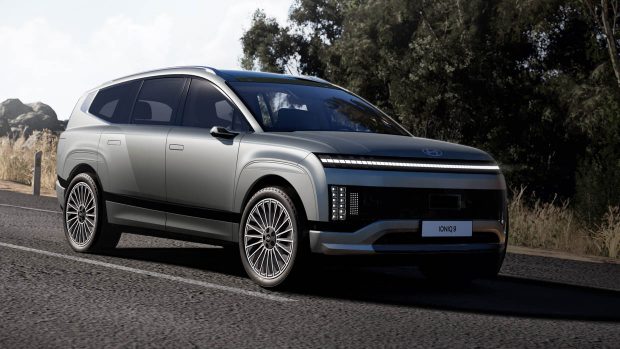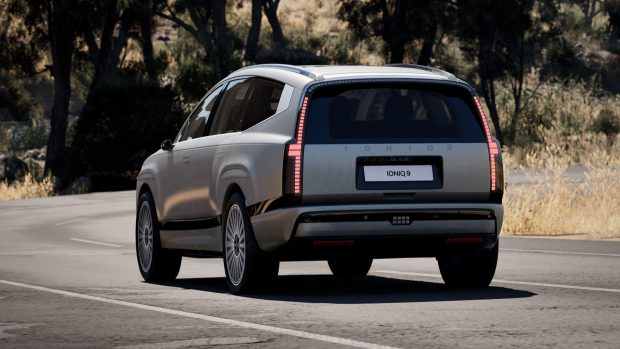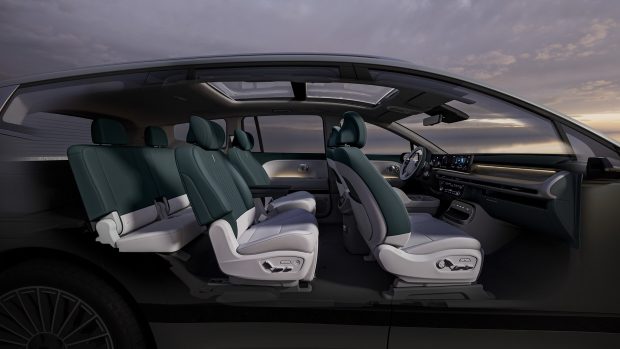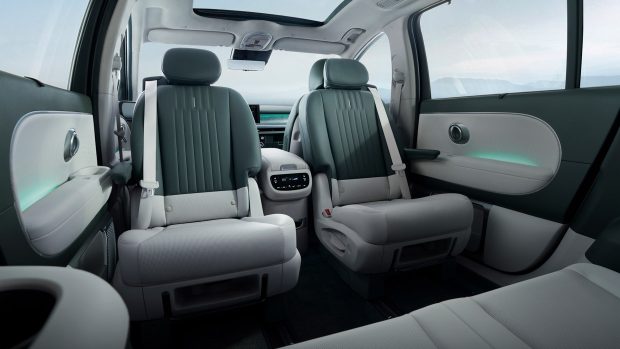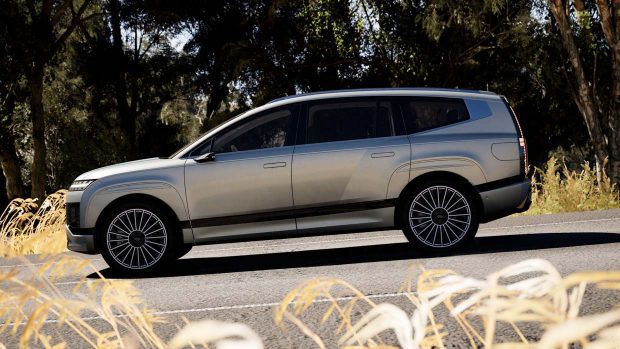-
Car Reviews
- Car News
-
Car Comparisons
Latest comparisons
- Chasing Deals
Ioniq 9 follows Kia EV9 into the large electric market but makes up for the wait with performance, range and technology bonuses
Hyundai has pulled the sheets from its latest pure electric model with the Ioniq 9 going public at the Los Angeles Auto show and adding a seven-seat option to its growing family of zero-emissions models.
Local fans of the unorthodox people mover won’t have to wait long with the model expected to make its Australian debut in the first half of 2025 and up to three variants are expected to roll into showrooms.
Australian pricing and line-up is yet to be confirmed but it’s understood the Ioniq 9 will not differ greatly from the mechanically similar Kia EV9 which is already on sale from $97,000 up to $121,000 for the current range-topper.
Like its South Korean sister model, the Ioniq 9 is offered in three core variants – a Long-Range rear-wheel drive with a single drive motor, or a pair of dual-motor AWD versions that will be available in Long-Range or Performance versions.
With a single 160kW motor at its disposal, the entry level Ioniq 9 does the 0-100km/h dash in 9.4 seconds but is the single-charge hero with up to 620km of range when fitted with the lowest-drag 19-inch wheels.
All-wheel drive versions don’t go as far but get you there quicker with the Long-Range and Performance Ioniq 9s accelerating from a standing start to 100km/h in just 6.7s and 5.2s respectively.
The Long-Range AWD has a 70kW/225Nm motor powering its front wheels and a 160kW/350Nm at the rear, while the Performance doubles down with the most potent unit fitted at both ends.
That means the newest Ioniq can’t quite match the Zeekr 009 fizzy family wagon for outright performance but beats it in range, price, and brand recognition, as well as offering a model that’s more geared toward to the school run rather than Nurburgring lap times.
Measuring more than 5.0 meters in length, about 2.0 meters wide and just less than 1.8 meters tall, the Ioniq 9 is about the same size as a Kia Carnival albeit about 100mm shorter in length. However, thanks to its battery powertrain, Hyundai says it fits a lot in along with a 3130mm wheelbase – the longest of any Hyundai to date.
Three rows of seating can accommodate up to seven occupants or six when optioned with the ‘captain’s chairs’ in the second row, while allowing flexible seating choices such as swivel chairs for a camper van or diner cubicle feel.
A central storage island is also moveable allowing more space in the front or second row but also offers more than 12 litres of storage in itself, while a similar unit between the second-row seats allows walk-though to the third row.
Occupants in the third row are not made to feel like second-rate passengers with lots of comfort features in the back stalls including 100-watt USB-C charging sockets. That’s not a typo – the Ioniq’s device chargers are tapped directly into the drive battery electrics rather than a 12-volt sub-system to offer enough power to charge laptops, for example.
All three rows have a pair of the high-power outlets, while the Ioniq 9 also offers vehicle-to-load (V2L) power enabling the owner to feed the battery into auxiliary equipment and other power consumers such as when camping or during power outages.
There are also curtain airbags that extend to all three rows while the rearmost seats also have seatbelt pretensioners offering a high grade of safety for all on board.
While the latest member of the Ioniq line-up has similarities to the already arrived Kia EV9, there are distinct differences including its battery which has a capacity of 110kWh, compared with the Kia’s 100kWh lithium-ion unit.
It also features radically different design inside and out which Hyundai refers to as ‘Aerosthetic’ and relates to the significant work put into reducing drag to increase efficiency. Indeed, the Ioniq 9 has a very slippery drag coefficient of as little as 0.259Cd.
Despite its large battery, the Ioniq 9 is capable of charging from 10 to 80 percent in just 24 minutes, claims Hyundai, made possible by the model’s 800-volt electrical architecture (400-volt is still the most commonplace among EVs).
Owners can keep an eye on the charging status via the four LED dots on the steering wheel that represent the letter H in Morse code but double as a battery level indicator.
There’s also a gauge in the dual-12-inch digital displays joined behind a seamless panel or the option to connect remotely to the vehicle via Hyundai’s app along with additional vehicle status and control features.
While BMW killed off many of its subscription features, Hyundai is having a crack at something similar with the Ioniq 9 with what it calls ‘feature on demand’ purchases, although it’s yet to detail the extras along with pricing and availability for Australia.
More conventional options include the replacement of traditional glass side mirrors with cameras that relay images from each side of the vehicle to a 7.0-inch organic LED screen at either end of the dash board, a UV-C sterilising compartment similar to that seen in the Hyundai Santa Fe, Digital Key, real-time road hazard alerts and a ‘Driver Safety Index’ which sounds a little Orwellian.
Latest news
About Chasing cars
Chasing Cars reviews are 100% independent.
Because we are powered by Budget Direct Insurance, we don’t receive advertising or sales revenue from car manufacturers.
We’re truly independent – giving you Australia’s best car reviews.
